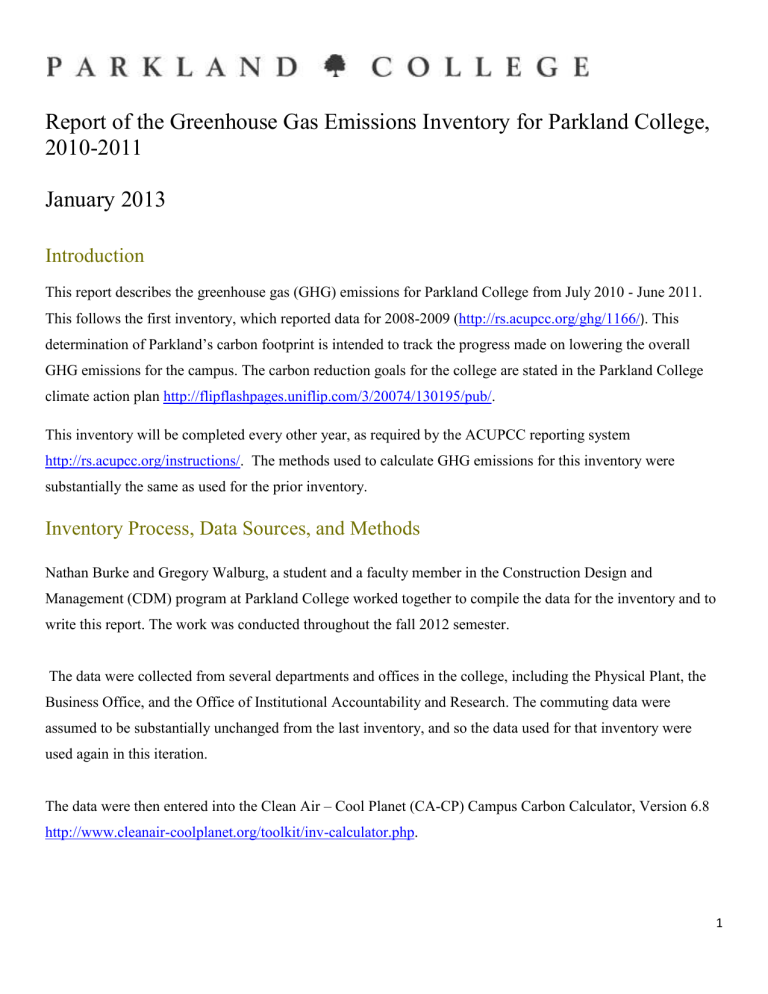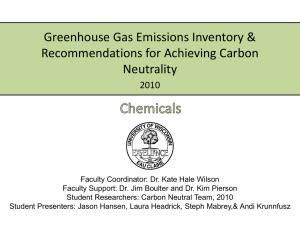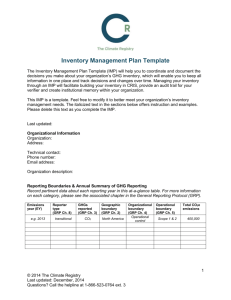Report of the Greenhouse Gas Emissions Inventory for Parkland

Report of the Greenhouse Gas Emissions Inventory for Parkland College,
2010-2011
January 2013
Introduction
This report describes the greenhouse gas (GHG) emissions for Parkland College from July 2010 - June 2011.
This follows the first inventory, which reported data for 2008-2009 ( http://rs.acupcc.org/ghg/1166/ ) . This determination of Parkland’s carbon footprint is intended to track the progress made on lowering the overall
GHG emissions for the campus. The carbon reduction goals for the college are stated in the Parkland College climate action plan http://flipflashpages.uniflip.com/3/20074/130195/pub/ .
This inventory will be completed every other year, as required by the ACUPCC reporting system http://rs.acupcc.org/instructions/ . The methods used to calculate GHG emissions for this inventory were substantially the same as used for the prior inventory.
Inventory Process, Data Sources, and Methods
Nathan Burke and Gregory Walburg, a student and a faculty member in the Construction Design and
Management (CDM) program at Parkland College worked together to compile the data for the inventory and to write this report. The work was conducted throughout the fall 2012 semester.
The data were collected from several departments and offices in the college, including the Physical Plant, the
Business Office, and the Office of Institutional Accountability and Research. The commuting data were assumed to be substantially unchanged from the last inventory, and so the data used for that inventory were used again in this iteration.
The data were then entered into the Clean Air – Cool Planet (CA-CP) Campus Carbon Calculator, Version 6.8 http://www.cleanair-coolplanet.org/toolkit/inv-calculator.php
.
1
The CA-CP calculator is an Excel based spreadsheet which converts GHG emissions data to CO
2
equivalents, using a format specifically developed for use in higher education. Reports can be readily generated from the data, and the data can be extrapolated to show campus trends, including enrollment growth, building growth, energy consumption, and GHG emissions.
The two basic calculator inputs are institutional data and emissions sources. Institutional data include operating budget, energy budget, numbers of student, faculty and staff, and building size. The GHG emission sources are divided into three categories, referred to as Scopes 1, 2, and 3. These categories reflect the varying amounts of control that the institution has over the emissions sources, from direct to very indirect control. Scope 1 sources are those directly controlled by the college and include those produced by institution owned processes, such as onsite energy production, agriculture, and cogeneration for heating. College vehicle fleet fuel usage and chemical use are also included as in Scope 1 emissions. Scope 2 emissions are produced offsite, including electricity, chilled water, and steam. Scope 3 sources include commuting and college financed travel. It also includes paper consumption and both liquid and solid waste. Scope 3 also allows input of any offsets, such as composting, forest preservation and purchased energy offsets.
Data collected for this inventory including the number of faculty and staff, number of full, part time, and summer school students, total building square footage, and purchased electricity. The boundaries of the college for this audit include the main campus on Bradley Ave, the Mattis Ave building, the Kenyon Road building, the
Parkland unit sign on Bradley Ave, and the RR4 building, all of which are located in Champaign.
Results
The results from the CA-CP calculator are broken down by both scope and by the type of GHG emitted. The greenhouse gases covered are carbon dioxide (CO
2
)
, methane (CH
4
)
, and nitrous oxide (N2O). The three gases are given by the weight of their production in kilograms (kg). All greenhouse gases are then reported as CO
2 equivalents to simplify comparisons; each scope is expressed in metric tonne equivalents of CO
2
(MT eCO
2
).
Energy production is measured in Million British Thermal Units (MMBTU). This category is important in reviewing environmental control efficiency for building spaces. The CA-CP calculator can also show amounts of energy consumed and GHG emitted per various units, including by student count, per dollar of operating cost, and per square foot of building space. These options enable the calculator user to readily make comparisons to result from other users.
2
For this version of the calculator we collected data collected for this inventory including the number of faculty and staff, number of full, part time, and summer school students, total building square footage, and purchased electricity. The boundaries of the college for this audit include the main campus on Bradley Ave, the Mattis Ave building, the Kenyon Road building, the Parkland unit sign on Bradley Ave, and the RR4 building all of which are located in Champaign.
WORKSHEET Overview of Annual Emissions
UNIVERSITY Parkland College
Energy
Select Year --> 2011
Consumption
MMBtu
Scope 1 -
-
Scope 2
Scope 3
Offsets
Totals
Co-gen Electricity
Co-gen Steam
Other On-Campus
Stationary
Direct Transportation
Refrigerants &
Chemicals
Agriculture
Purchased Electricity
Purchased Steam /
Chilled Water
Faculty / Staff
Commuting
Student Commuting
Directly Financed
Air Travel
Other Directly
Financed Travel
Study Abroad Air
Travel
Solid Waste
Wastewater
Paper
Scope 2 T&D Losses
Additional
Non-Additional
Scope 1
Scope 2
Scope 3
All Scopes
All Offsets
-
-
-
-
-
-
CO kg
2
-
-
-
-
-
-
CH kg
4
-
-
-
-
187,434.4 15,275,384.2 232.4
-
-
123,115.5 8,713,408.3 1,752.9
-
-
-
-
-
-
-
-
-
-
-
-
-
-
-
-
-
-
-
-
18,537.5 1,510,752.3 23.0
-
187,434.4 15,275,384.2 232.4
141,653.0 10,224,160.6 1,775.9
329,087.4 25,499,544.8 2,008.2
-
-
-
-
N
2
O kg
-
-
-
-
-
-
335.9
-
-
590.4
-
-
-
-
-
-
33.2
-
335.9
623.6
959.6
Net
Emissions: eCO
2
Metric Tonnes
-
-
-
-
-
-
15,381.3
-
-
8,933.2
-
-
25,835.7
-
-
-
-
1,521.2
-
-
-
15,381.3
10,454.4
25,835.7
-
3
The above table shows a summary of the calculator results. The resultant quantities of emissions in Metric tonnes by scope are: Scope 1 - 0 MT eCO
2
; Scope 2 - 15,381.3 MT eCO
2
; Scope 3 - 1-,454.4 MT eCO
2
. The three categories combined for a net amount of 25,835.7 Metric tons eCO
2 produced.
The following chart represents the CO
2
emissions contributions by percentage.
Scope 2 T&D
Losses
6%
Student
Commuting
35%
Purchased
Electricity
60%
In this current model purchased electricity makes up all of the Scope 2 emissions for Parkland College. The energy consumption from Scope 2 was 187,434.4 MMBTU and the total energy consumption was 205,971.9
MMBTU. Finding ways for the college to reduce energy consumption is important to Parkland’s commitment to lowering GHG emissions.
Comments and future direction
Since the first GHG inventory report in May of 2010, Parkland College has taken steps to reduce energy use and the concomitant carbon emissions. The energy reduction efforts included the installation of more energy efficient lights, installation of lighting controls to turn off lights in un-occupied spaces, automatic power reduction software for computers, and energy reducing features for the campus data center. Despite these efforts, the emissions data still reflect a small increase in CO
2 emissions (23,733.3 MT eCO
2
2009 and 25,835.7
4
MT eCO
2
2011). Some of this increase can be accounted for by the increased use of computers and other electronic devices on campus.
The college is also engaged in a major building growth phase, with three major new buildings or renovations under construction or recently completed (as of December 2012). The additional square feet added to the campus footprint will increase GHG emissions. However, the new buildings are being constructed to LEED standards, and will be expected to be more energy efficient than typical buildings.
This inventory is the second iteration of a process that will be continually improved. The CA-CP calculator is capable of analysis of project costing and carbon footprint assessment for proposed programs. These calculator tools can be used to help Parkland College to reduce its GHG emissions and to save money, and in so doing become a more sustainable entity.
5






